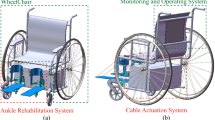Abstract
Ankle injuries are common in daily life, and the recovery process requires rehabilitation training. Manual rehabilitation training relies on doctors, which is inefficient, labor intensive, difficult to popularize and evaluate the rehabilitation effect objectively and accurately. Rehabilitation equipment overcomes above shortcomings and can achieve precise treatment, which has become an important part of the public health and health protection system. In this paper, a new cable-driven rehabilitation device is proposed for the ankle rehabilitation. The cable-driven technology reduces the weight and volume of the mechanical structure and mitigates the rigid impact with the cable flexibility. Besides, it improves the integration of sensing, driving and control. According to the movement requirements of human ankle joints, the configuration of the rehabilitation device was proposed. On this basis, a multi-parameter-oriented stepwise optimization method was established to minimize the maximum cable force, considering the constraints of volume and scale. The optimal dimension was deduced on the basis of the performance trend analysis. Finally, a virtual prototype of the rehabilitation mechanism was designed to form the new ankle joint rehabilitation equipment.
Access this chapter
Tax calculation will be finalised at checkout
Purchases are for personal use only
Similar content being viewed by others
References
Schmidt, H., Werner, C., Bernhardt, R., Hesse, S., Kruger, J.: Gait rehabilitation machines based on programmable footplates. J. NeuroEng. Rehabil. 4, 1–7 (2007)
Hesse, S., Tomelleri CzBardeleben, A., Werner, C., Waldner, A.: Robot-assisted practice of gait and stair climbing in nonambulatory stroke patients. J. Rehabil. Res. Dev. 49, 613–622 (2012)
Wang, Z., Cui, L., et al.: Modeling analysis and structural design of human lower limb rehabilitation robot (2018)
Duschau-Wicke, A., Caprez, A., Riener, R.: Patient-cooperative control increases active participation of individuals with SCI during robot-aided gait training. J. NeuroEng. Rehabil. 7, 13 (2010)
Veneman, J., Kruidhof, R., Hekman, E., Ekkelenkamp, R., Van Asseldonk, E., van der Kooij, H.: Design and evaluation of the LOPES exoskeleton robot for interactive gait rehabilitation. IEEE Trans. Neural Syst. Rehabil. Eng. 15(3), 379–386 (2007)
Van Asseldonk, E.H.F., Ekkelenkamp, R., Veneman, J.F.Z., Van der Helm, F.C.T., van der Kooij, H.: Selective control of a subtask of walking in a robotic gait trainer(LOPES). In: 2007 IEEE 10th International Conference on Rehabilitation Robotics, vols. 1 and 2, pp. 841–848 (2007)
Kazerooni, H., Steger, R., Huang, L.: Hybrid control of the Berkeley Lower Extremity Exoskeleton (BLEEX). Int. J. Robot. Res. 25(5–6), 561–573 (2006)
Schmidt, H.: Hapticwalker-a novel haptic device for walking simulation. In: Proceedings of EuroHaptics, Tokyo, Japan, pp. 66–67 (2004)
Saglia, J.A., Tsagarakis, N.G., Dai, J.S., Caldwell, D.G.: A high-performance redundantly actuated parallel mechanism for ankle rehabilitation. Int. J. Robot. Res. 28(9), 1216–1227 (2009)
Wang, C., Fang, Y., Guo. S., et al.: Design and kinematical performance analysis of a 3-rus/rrr redundantly actuated parallel mechanism for ankle rehabilitation. J. Mech. Robot. 5, 041003 (2013)
Jamwal, P.K., Aw, K.C., Xie, S.Q., Tsoi, Y.H.: Multi-criteria optimal design of cable driven ankle rehabilitation robot. In: Mobile Robots-State of the Art in Land, Sea, Air, and Collaborative Missions. INTECH Open Access Publisher, London (2009)
Shahrol, M.N., Basah, S.N., Basaruddin, K.S., Ahmad, W.K.W., Ahmad, S.A.: Modelling of a Cable-driven ankle rehabilitation robot. J. Telecommun. Electron. Comput. Eng. 10, 53–59 (2018)
Russo, M., Ceccarelli, M.: Analysis of a wearable robotic system for ankle rehabilitation. Machines 8(3), 48 (2020)
Gouttefarde, M., Gosselin, C.: Analysis of the wrench-closure workspace of planar parallel cable-driven mechanisms. IEEE Trans. Rob. 22(3), 434–445 (2006)
Quintero-Riaza, H., Mejía-Calderón, L., Díaz-Rodríguez, M.: Synthesis of planar parallel manipulators including dexterity, force transmission and stiffness index. Mech. Based Design Struct. Mach. 47(6), 680–702 (2019)
Lamine, H., Laribi, M., Bennour, S., Romdhane, L., Zeghloul, S.: Structure optimization of the cable driven legs trainer. In: Ferraresi, C., Quaglia, G. (eds.) Advances in Service and Industrial Robotics, pp. 691–698. Springer International Publishing, Cham (2018). https://doi.org/10.1007/978-3-319-61276-8_73
Gao, Z., Zhang, D., Ge, Y.: Design optimization of a spatial six degree-of-freedom parallel manipulator based on artificial intelligence approaches. Robot. Comput.-Integr. Manuf. 26(2), 180–189 (2010)
Liu, X.J., Wang, J.S.: A new methodology for optimal kinematic design of parallel mechanisms. Mech. Mach. Theory 42(9), 1210–1224 (2007)
Shao, Z.F., Tamg, X.Q., Wang, L.P., et al.: Atlas based kinematic optimum design of the stewart parallel manipulator. Chin. J. Mech. Eng. 28(1), 20–28 (2015)
Brockett, C.L., Chapman, G.J.: Biomechanics of the ankle. Orthop. Trauma 30, 232–238 (2016)
Acknowledgement
This work was supported by the National Natural Science Foundation of China (grant number U19A20101).
Author information
Authors and Affiliations
Corresponding author
Editor information
Editors and Affiliations
Rights and permissions
Copyright information
© 2021 Springer Nature Switzerland AG
About this paper
Cite this paper
Huo, Y., Duan, J., Shao, Z., Liu, H., Liu, C. (2021). Design and Optimization of the New Cable-Driven Ankle Rehabilitation Equipment. In: Liu, XJ., Nie, Z., Yu, J., Xie, F., Song, R. (eds) Intelligent Robotics and Applications. ICIRA 2021. Lecture Notes in Computer Science(), vol 13013. Springer, Cham. https://doi.org/10.1007/978-3-030-89095-7_57
Download citation
DOI: https://doi.org/10.1007/978-3-030-89095-7_57
Published:
Publisher Name: Springer, Cham
Print ISBN: 978-3-030-89094-0
Online ISBN: 978-3-030-89095-7
eBook Packages: Computer ScienceComputer Science (R0)




